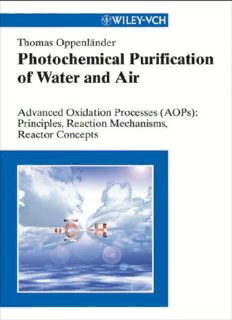
Photochemical Purification of Water and Air: Advanced Oxidation Processes (AOPs): Principles, Reaction Mechanisms, Reactor Concepts PDF
Preview Photochemical Purification of Water and Air: Advanced Oxidation Processes (AOPs): Principles, Reaction Mechanisms, Reactor Concepts
Thomas Oppenländer Photochemical Purification of Water and Air ThomasOppenländer Photochemical Purification of Water and Air Thomas Oppenländer Photochemical Purification of Water and Air Author n This book was carefully produced. Nevertheless, authorandpublisherdonotwarranttheinforma- ThomasOppenländer tioncontainedthereintobefreeoferrors.Rea- UniversityofAppliedSciences dersareadvisedtokeepinmindthatstatements, (Fachhochschule)Furtwangen data,illustrations,proceduraldetailsorother DepartmentofMechanicaland itemsmayinadvertentlybeinaccurate. ChemicalEngineering Jakob-Kienzle-Str.17 LibraryofCongressCardNo.: 78054Villingen-Schwenningen Appliedfor. Germany Email:[email protected] BritishLibraryCataloguing-in-PublicationData: Acataloguerecordforthisbookisavailablefrom JoséFranco-Pereira,whoreceivedthedegreeofa theBritishLibrary. MagisterArtium(M.A.)infilmandmediasci- encesattheUniversityofFrankfurt(Germany), Bibliographicinformationpublishedby kindlydesignedthecoverpicture. DieDeutscheBibliothek DieDeutscheBibliothekliststhispublicationin theDeutscheNationalbibliografie;detailedbiblio- graphicdataisavailableintheInternetat <http://dnb.ddb.de>. 2003WILEY-VCHVerlag GmbH&Co.KGaA,Weinheim Allrightsreserved(includingthoseoftranslation inotherlanguages).Nopartofthisbookmaybe reproducedinanyform–byphotoprinting,mi- crofilm,oranyothermeans–nortransmittedor translatedintomachinelanguagewithoutwritten permissionfromthepublishers.Registered names,trademarks,etc.usedinthisbook,even whennotspecificallymarkedassuch,arenotto beconsideredunprotectedbylaw. PrintedintheFederalRepublicofGermany. Printedonacid-freepaper. Composition K+VFotosatzGmbH,Beerfelden Printing betzdruckGmbH,Darmstadt Bookbinding Litges&DopfBuchbinderei GmbH,Heppenheim ISBN 3-527-30563-7 V Foreword The field of Advanced Oxidation Processes (AOPs) or Advanced Oxidation Technolo- gies (AOTs) is of relatively recent vintage. However, AOPs/AOTs are proving to be important contributions to the treatment of water and air to remove harmful and toxic contaminants. Thus, it is gratifying to see this very comprehensive and authoritative treatise appear covering all aspects of AOPs/AOTs. These range from the treatment of industrial wastewaters, drinking water (both contaminant re- moval and disinfection), ultrapure water to the purification and deodorizingof air. Light sources include low pressure and medium pressure UV lamps, flash lamps, incoherent excimerlamps and sunlight itself. This treatise includes 146 figures, 17 worked out examples and 37 tables (many of which contain valuable collections of data and references). Each of the nine chapters cites extensive references, including very recent papers where the reader can follow up information in moredetail. Professor Oppenländer is well qualified to write about AOPs/AOTs, since he has contributedto this literature in a very significant manner. It is thus particular- ly valuable to see the application of incoherent excimer lamps covered so well, a subject that has been a central part of his research. Finally, it is good to see care- ful attention being made to consistent terms, definitions and units in accord with IUPACrecommendations. This book will be of considerable value to graduate students, science and engi- neering faculty, scientists, process engineers and sales engineers in industry, government regulators and health professionals and all others with an interest in purifying our water and air. JamesR. Bolton President,Bolton PhotosciencesInc. 628 Cheriton Cres.,NW, Edmonton AB, Canada T6R 2M5 VI Curriculum vitae Thomas Oppenländer studied chemistry at the University of Würzburg (Germany). He received his doctoral degree (Dr. rer. nat.) in 1984 working in the research group of Waldemar Adam on 185-nm-photochemistry of azoalkanes in solution. The following year was spent as a postdoctoral fellow at Colorado State University (Fort Collins, USA) in the group of Albert I. Meyers being involved in the asym- metric synthesis of dihydropyridines and NADH mimics. From 1985 to 1991 he was affiliated with F. Hoffmann-La Roche in Basel (Switzerland). Here he was engaged in research on drug phototoxicity and on the photochemical production of fine chemicals. Since 1991 he has been a full professor at the University of Applied Sciences (Fachhochschule) of Furtwangen (Germany) in the Department of Mechanical and Chemical Engineering, where he has been involved in photo- initiated advanced oxidation technologies. His main interests concentrate on the potentials of novel incoherent excimer lamps for photochemical treatment of water and air. VII Preface This book is aimed at researchers, engineers, and students who deal with prob- lems in the expanding field of photo-initiated process technologies of water or air treatment. It lays claim to be a mine ofinformation related to these interdisciplin- ary topics and presents a selection of the most important primary and secondary literature in this area of research and development. Clearly not all references of the vast research literature could be incorporated. The detailed discussion of many examples taken from the current scientific literature facilitates access to re- search topics of particular interest from different but interrelated point of views. This is supported by tables that collect together interesting studies, which deal with new developments of photochemical advanced oxidation processes and tech- nologies allowing easy access to the primary scientific literature. A most impor- tant feature of this book is that it presents many detailed figures for the purpose of visualization of photochemical and photophysical phenomena, for the presenta- tion of the underlying basic principles and for the interpretation of important re- search results. Additionally, several helpful example calculations are presented to demonstrate the use of quoted equations dealing, for example, with photons and reaction kinetics. This idea is thought to be very helpful in the understanding of the mathematical relationships presented Thus, the readerwill becomeacquaintedwith the basicknowledge that isessen- tial for an understanding of photochemical processes.This will enable him/her to carry out laboratory and large-scale experiments with the aim of developing and improving AOPs. There are many researchers and engineers in water and air in- dustries who require more extensive and novel information than that which is ob- tainable from textbooks that have their emphasis placed on tradition. Therefore, this book intends to supply such missing information to as great an extent as is possible. To avoid any misinterpretations concerned with the digit style of numbers, the decimal point is used throughout the book instead of a comma (i.e. computer no- tation: 1.03 instead of 1,03, except for some graphical representations). In repre- sentative molecular structures, spin-paired non-bonding electrons around an atom of a molecule are represented (if necessary) by a bold line “(cid:2)”, in accord with commonly used Lewis-structures. Single electrons are represented by a dot “•”. A full arrow ((cid:2)) indicates shifts of electron pairs, whereas single electron shifts are
Description: